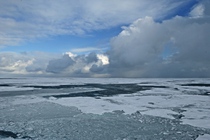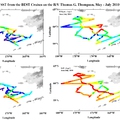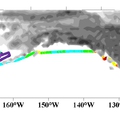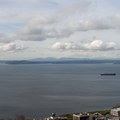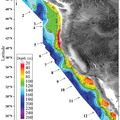Research in the Arctic
A sentinel for global change
high latitude marine ecosystems provide a real-time laboratory for the evaluation of potential impacts to organisms, and the subsequent impact to the foodweb, at accelerated rates compared to mid and lower latitudes
Recent studies have shown the Arctic is undergoing significant change. In 2011, the summer sea-ice minimum was the second lowest in recorded history (2007 was the lowest recorded minimum). This, along with changes in terrestrial fluxes and warming temperatures, have likely cascaded into the ecosystems with unknown consequences to primary production, air-sea exchange of CO2, the fate of organic matter, and the extent and responses to ocean acidification. It is critical to gain a better understanding of how these processes impact the carbon biogeochemistry of the region.
The cold waters of high latitude regions are particularly sensitive to ocean acidification because they are naturally low in carbonate ion concentration due to ocean mixing patterns and the increased solubility of CO2 at low temperatures. Consequently, seawater carbonate mineral saturations are typically lower in polar and sub-polar areas than in temperate and tropical regions. Limited data have shown that most surface waters of high latitude oceans are presently supersaturated with respect to aragonite, a mineral form of calcium carbonate that is about 50% more soluble than calcite. However, recent observations (Fabry et al., 2009; Yamato Kawai et al., 2009; Mathis et al., In Prep) in the Bering Sea and Arctic Ocean have found locations where waters are undersaturated with respect to aragonite at the surface, and models project that under current rates of CO2 emissions, even larger areas of the Arctic Ocean and parts of the subarctic Pacific could become undersaturated with respect to aragonite by as early as 2023 (Orr et al., 2005; Steinacher et al., 2009). These rapid rates of change in high latitudes could have major consequences for both pelagic and benthic calcifiers, as well as cascading effects up the foodweb. Thus, high latitude marine ecosystems provide a real-time laboratory for the evaluation of potential impacts to organisms, and the subsequent impact to the foodweb, at accelerated rates compared to mid and lower latitudes.
PMEL is working with partners at University of Alaska, Fairbanks, to study carbon cycling in high latitude regions, including the northern Gulf of Alaska (mooring to be installed spring 2011), Bering Sea (underway pCO2 on BEST cruises, mooring to be installed May 2011), and the Beaufort/Chuckchi and Canada deep basin (upcoming field program 2011-2013). The goal of this work is to develop a better understanding of the natural variability in carbon system parameters like pH and pCO2, and how these properties regulate and are regulated by air-sea exchange, ecosystem community production, and ocean circulation patterns. By doing this, it will be possible to determine how physical forcing (e.g., sea-ice, nutrient supply, stratification, etc.) and biological responses exert different controls on the marine carbon cycle and how these mechanisms may buffer or accelerate the response of this region to future climate change and ocean acidification.

